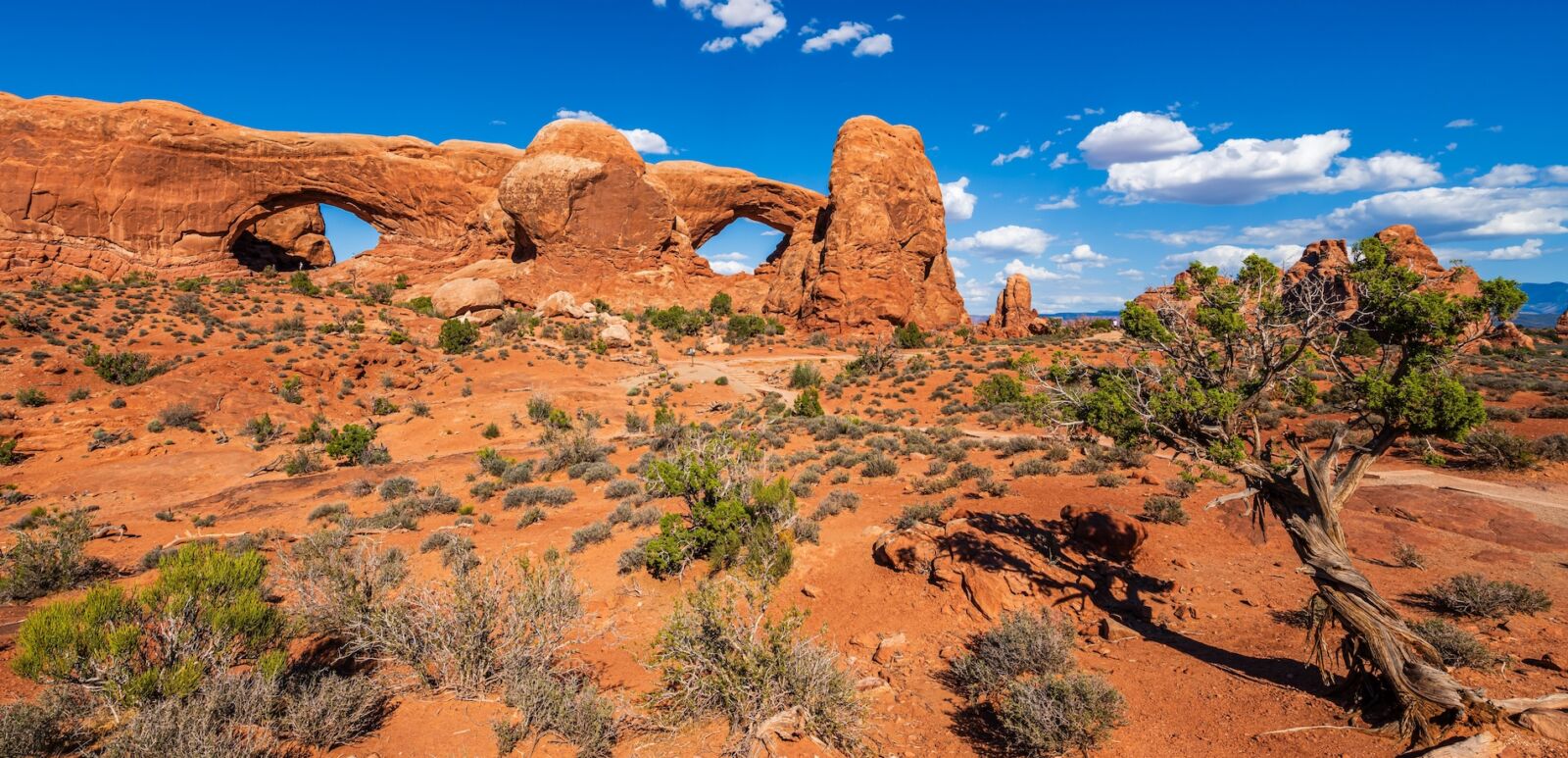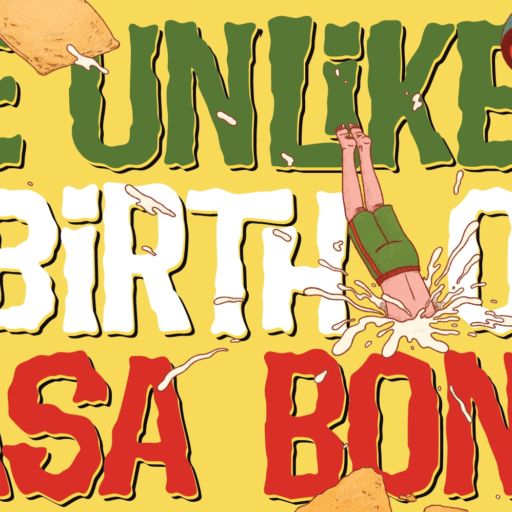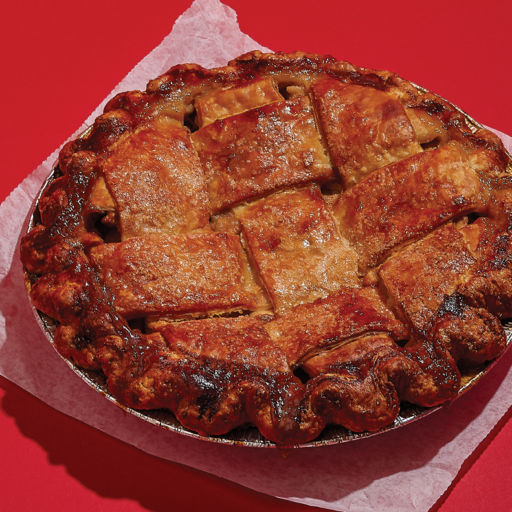Tucked near the entrances of America’s most iconic natural wonders, gateway cities are traditionally the spots where you grab your last cup of real coffee, pick up those forgotten hiking essentials, and maybe even savor one last night in a cozy bed before trading it all for campfires and starlight. They were about convenience.
Some communities break that mold. They’ve even become an essential part of the national park experience. Take Moab, Utah, for example—just minutes from both Arches and Canyonlands National Parks, but also home to world-class mountain biking, a thriving arts scene, and some of the best southwestern food you’ll find. Jackson, Wyoming, is the iconic gateway to Grand Teton and Yellowstone, where you can start your morning with a hike and end your evening with live music at a cowboy bar.
Far from being just put stops on along the way, these national park gateway cities — which offer a mix of art galleries, breweries, farm-to-table restaurants and historic districts that echo the region’s wild past — are destinations in their own right.
Bar Harbor, Maine
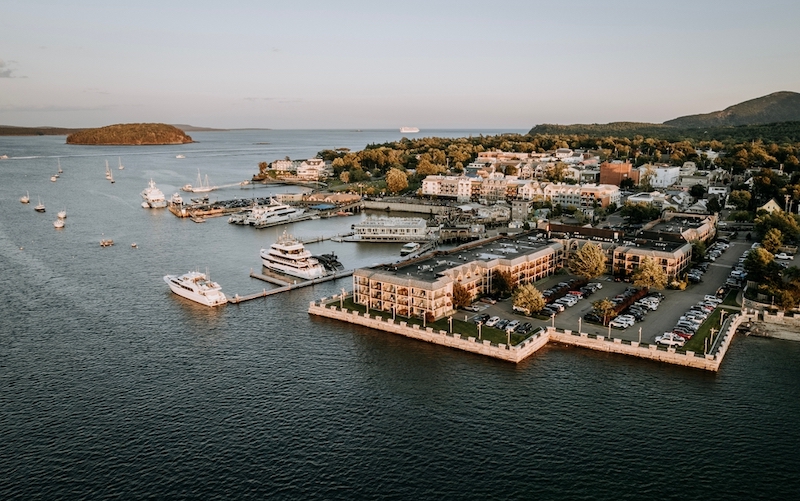
Zero miles to Acadia National Park
The seamless transition from its bustling harbor streets to the breathtaking beauty of Acadia’s trails, peaks, and shoreline sets Bar Harbor apart as a gateway town. You can literally jump on a trail downtown and be in the national park within minutes. Here, hikers can be among the first in the country to see the sunrise over the Atlantic from atop Cadillac Mountain, while paddlers glide past rocky cliffs and supercentenarian lighthouses, spot harbor seals, or catch glimpses of puffins diving for fish in the briny waters of Frenchman Bay. History and culture come to life in places like the Abbe Museum, which celebrates the heritage of the Wabanaki people, offering deeper insight into the area’s cultural roots. Visitors can learn more about Maine’s coastal creatures at The Oceanarium & Education Center, where there are resident lobsters in rare shades of blue, orange, and cotton candy pink. And if, for some reason, they find themselves hungry for fresh seafood, Side Street Cafe has a decadent lobster mac and cheese, Testa’s Restaurant offers fried lobster tail tacos, and Ben & Bill’s Chocolate Emporium inexplicably sells an ice cream dotted with frozen chunks of lobster. There are oodles of historic inns in Bar Harbor, though Queen Anne’s Revenge and Wonder View Inn are two of the most charming.
Cleveland, Ohio
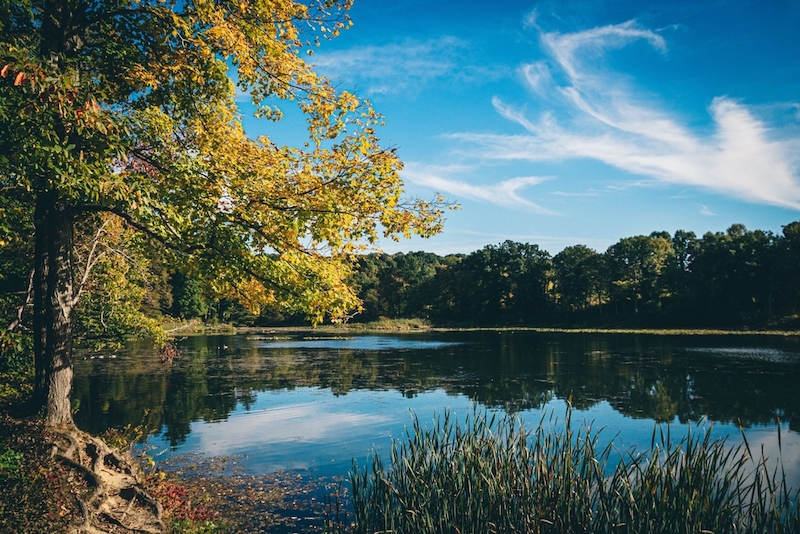
20 miles to Cuyahoga Valley National Park
Cuyahoga Valley National Park is 20 miles outside of Cleveland, a city that often gets summarized by its Rock and Roll Hall of Fame, a trio of sports teams, and its devotion to Polish Boy (a snappy sausage topped with cabbage and fries and drizzled with bbq sauce). But that’s far from all The Land has going for it. Hugging the southern shore of Lake Erie, Cleveland has eight lakefront parks and over 100 hiking trails in the Metroparks system, which means there are loads of outdoor activities in the city, from urban kayaking to relaxing on the beach. You’ll also find a diverse culinary landscape, reflecting traditions from Italian, Hungarian, and Slovenian culinary canons, just to name a few—you can visit the historic West Side Market to nosh on each. Vintage cocktail lounges like Society Lounge and The Spotted Owl provide an atmospheric prelude to the night’s festivities, with VAULT adding a layer of Prohibition-era mystique to your drinks. For accommodations, consider The Hotel Cleveland, a city center stunner with 1920’s architecture, or Stone Gables Inn, a five-room historic inn built in 1883.
Jackson, Wyoming
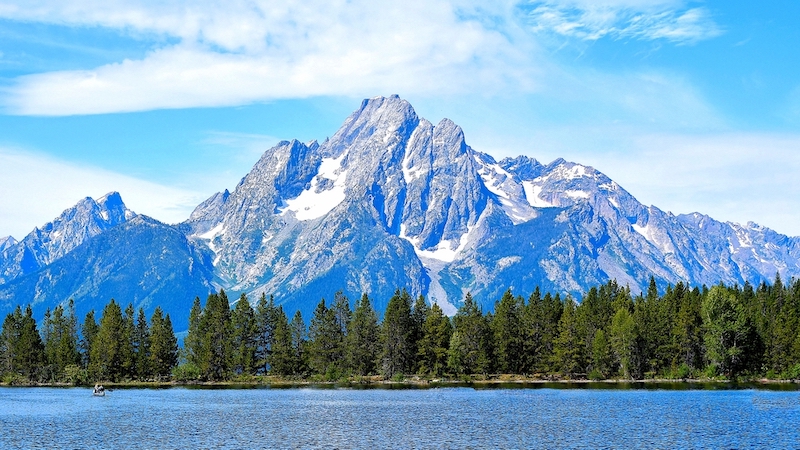
24 miles to Grand Teton National Park and 45 miles to Yellowstone National Park
Not only is Jackson the gateway community to two of the nation’s most well known national parks, but the town offers myriad cultural experiences. It’s host to the Jackson Hole rodeo, a tradition dating back to 1890 that has classic Western events like barrel racing and bull riding, as well as galleries and exhibits, such as the Uncommon Art Residency, which showcases works from artists all over the world. The historic Town Square, with its famous elk antler arches, is lined with restaurants, like farm-to-table eatery The Kitchen and the comfort-food-slinging Snake River Grill, as well as watering holes, like the famed Silver Dollar Bar, where there’s often live music, and many shops, like outdoors outfitters. Stay at Hotel Jackson, an upscale boutique hotel in the center of town, or The Virginian Lodge, a roadside motel turned Western-style lodge. For those traveling with a large group or on a tighter budget, Cache House is a solid alternative, with 50 individual bunks in the classic European hostel style, complete with secure storage drawers and private bathrooms and showers.
Moab, Utah
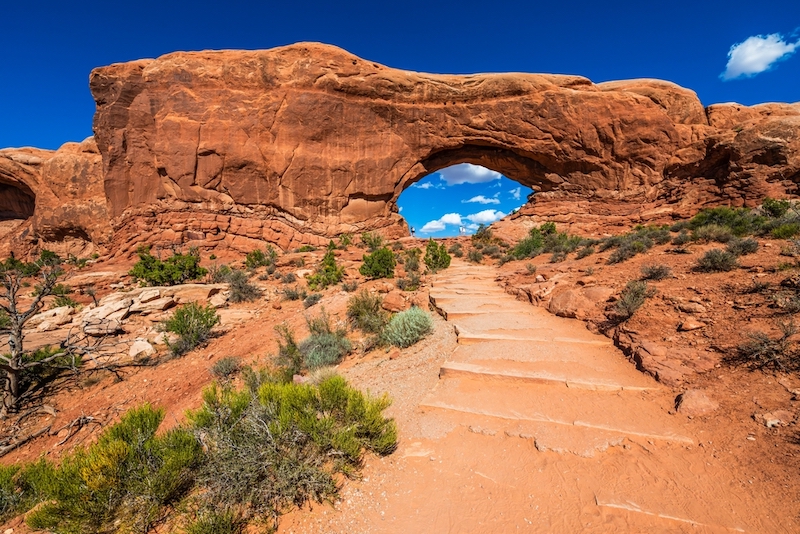
Five miles to Arches National Park and 30 miles to Canyonlands National Park
Moab is well known for outdoor adventurists given that it is uniquely positioned between two of America’s most awe-inspiring national parks—Arches and Canyonlands. Arches National Park, just a five-minute drive from downtown, has more than 2,000 natural sandstone arches, like Delicate Arch and Devil’s Garden. Canyonlands, a short 30-minute drive away, offers more rugged and remote experiences, with jaw-dropping overlooks like Grand View Point and the Island in the Sky mesa. While there are endless opportunities for backcountry hiking, mountain biking, and off-roading in the area, it’s worth sticking around to explore Moab, which has made a name for itself as a destination for art lovers and foodies. You can spend the morning wandering between the various galleries and shops, like Moab Made, a co-op with watercolor paintings, prints, and handmade jewelry from local artists. Then you can spend the afternoon learning local history at the Moab Museum or discovering the area’s prehistoric past at Moab Giants, a museum with more than 100 full-scale dinosaur replicas. For dining, consider Antica Forma, where the wood-fired Neapolitan pizzas are generously topped, or Milt’s Stop & Eat, a burger spot that has been dishing up patties, hand-cut fries, and malts since 1954. Afterward, grab a flight at Moab Brewery or a craft cocktail at Raven Room. There are also a slew of boutique hotels in the area, like Moab Under Canvas, Gravity Haus Moab, and Red Cliffs Lodge.
Ranier, Minnesota
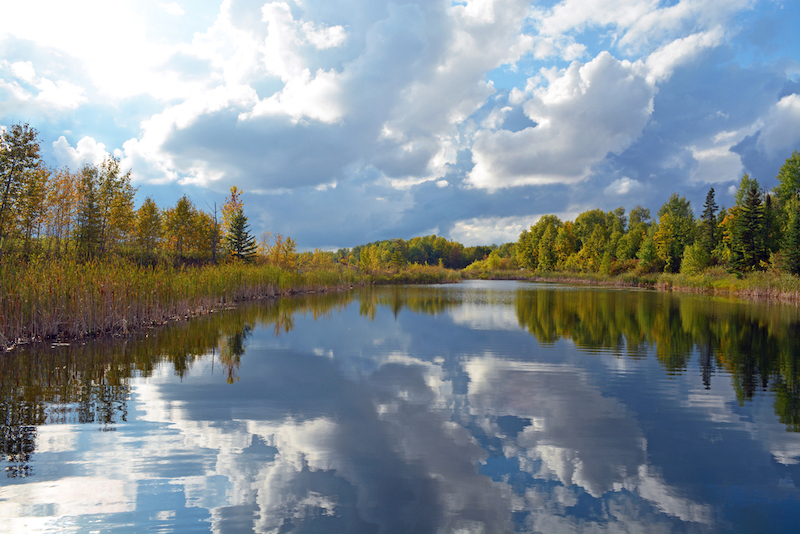
Eight miles to Voyageurs National Park
Voyageurs National Park may be known for its spectacular fishing, boating, and starry skies, but its criminally underrated gateway town, Ranier, is worth a visit, too. Located on the shores of Rainy Lake and just across the border from Canada, Ranier has outdoor pursuits aplenty. Woody’s Fairly Reliable Guide Service takes anglers out for a day of smallmouth bass, crappie, and northern pike fishing. Or you could grab a bike and hit The Rainy Lake Recreation Trail and perhaps end up at Loony’s Brew, a brewpub with a rotating tap list of local and regional beers and an outdoor patio with lakefront views. For more potent potables, there’s also Cantileveer Distillery and Restaurant, which offers made-in-Minnesota spirits, craft cocktails, and elevated pub fare, like walleye tacos. For those who have knocked back a few too many of Cantileveer’s lavender smoked old-fashioned, there’s a boutique hotel upstairs, where many of the rooms have claw-foot tubs.
Seward, Alaska

Two miles to Kenai Fjords National Park
Most of Alaska’s national parks don’t have traditional gateway towns—often, the closest town is a bush plane ride away. However, Seward, a commercial fishing community on the Kenai Peninsula, is the exception. From here, park goers can venture into Kenai Fjords National Park by boat, which is the best way to see the dramatic tidewater glaciers and spot marine life like orcas, sea otters, and puffins. Alternatively, it’s just a two-mile drive from downtown to the trailhead to one of Alaska’s most accessible ice floes, Exit Glacier. In the heart of Seward, the small harbor is perfect for a casual walk, where you can watch fishing boats with punny names bring in the day’s catch. For history buffs, the Seward Museum provides fascinating insight into the town’s past, including its role in the Iditarod Trail and the Alaska SeaLife Center is where you can learn about the region’s marine life and conservation efforts (and poke starfish and sea urchins in the touch tank). Seward’s downtown streets are home to many colorful murals if you’re looking for a dose of art or visit Resurrect Art Coffee House, a coffee shop and gallery housed in an old Methodist church. Given that Seward is a fishing community, you can expect excellent seafood—be sure to get the Bucket of Butt (lightly fried chunks of halibut) at Flamingo Lounge. And while you could visit Seward on a day trip from Anchorage, we’d recommend staying the night—Salted Root and its sister property, Rustic Roots, offer cozy cabins overlooking Resurrection Bay.


